Automata: 200-year-old robots
It is difficult to surprise someone with a robot. They are already among us - working in factories, saving people in emergency situations, disarming bombs, driving cars. Sometimes satisfy other human needs.
But what did it look like a couple of hundred years ago? Or four hundred years? Yes, then there were also some similarities of robots, mechanical devices resembling a human or an animal. They played musical instruments, wrote with a pen, danced, growled, and performed other actions that could shock a simple philistine. Today we are talking about mechanical monks laying eggs for ducks and programmable writing boys.
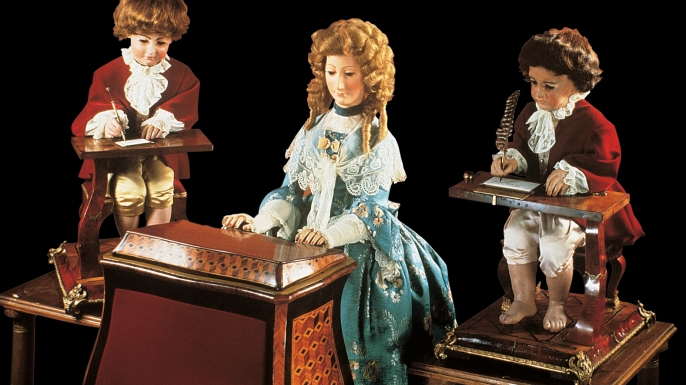
Automata are mechanisms. Various stories about humanoid robots went back in Ancient Greece - for example, moving statues. But the not very complicated mechanism that Philo of Byzantine described, who died in 220 BC, looks much more real. In the book "Pneumatics" he described the device in the form of a woman who holds a jug of wine in one hand, and on command - when setting the glass in the other hand - she poured wine and added water to it. But who needs robots if there are slaves?
')
Leonardo Da Vinci, the greatest artist, scientist, musician and inventor, in the XV century, developed the technology of a humanoid mechanism. It was the first ever android. Before creating it, Da Vinci spent a lot of time in the anatomical school, cutting corpses and learning the secrets of the human body.
The mechanism was inside the knight's armor. A knight could possibly walk, stand up and sit down, move his arms and neck. Unfortunately, the video was not filmed.


Sketch - fantasy of our modern artist
The King of Spain, Philip II, in 1560 ordered the engineer Huanelo Turriano to create a mechanical monk. A monk could be baptized, raise a crucifix, move his lips - he seemed to pray for the king. The figure moved on wheels, but for realism there were also legs, which are visible from under the cassock.

In 1737, the French inventor Jacques de Vaucanson built a flutist, whose repertoire included twelve musical compositions, as well as a musician with a tambourine.
Light man like blacksmith furs. Vaucanson, also keen on working with corpses, imitated their work. He had to learn the game of a living person. The movement of air controlled the tongue, the lips opened, closed and moved, the air came in from mechanical lungs - furs.
Flute holes were clamped in the desired sequence of mechanical fingers. Since the wooden fingers could not fit snugly to the flute, the master used real human skin.


Later, Vaucanson designed and assembled a four-part duck, which flapped its wings, ate, digested the grain, and then defecated. According to the author, the duck had to actually digest food using a chemical reaction in a separate tank, but, unfortunately, it did not come to that. Instead, the grain fell into one compartment, and the prepared excrements left the other. The duck became his most famous creation. All three automatons entered one collection and made presentations to the public.


The most important detail for the construction of automata has become an eccentric - a disk or sector of a disk, mounted on a rotating shaft so that its axis does not coincide with the axis of rotation of the shaft. Thus, the rotational movement becomes translational.
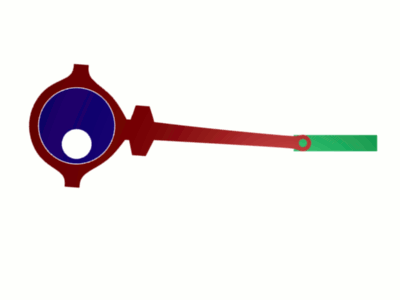
Of course, where are we without the Japanese, when it comes to fine work. The doll in the video below is driven by the strings with which it is connected with a mechanism similar to a sentry. Eccentrics stretch the strings and release them, causing the doll to perform various actions.
This doll is not just moving hands. She takes an arrow, pulls on a bow string and releases it. Then he takes a new boom from the platform, which has changed his position during the shot. In this case, the archer has time to artistically move his head.
In the 1740s, Archbishop Jacob von Dietrinstein (Jakob von Dietrichstein) built an automaton, which is a theater of two hundred figures on the same stage, working simultaneously. So he portrayed the life of an ideal city. We see how the coopers close the barrel, hammer the bull with a hammer, the builders lift the boards onto the building, and the aristocracy is watching the hard work of ordinary people from above.
The water in the mechanism turns the wheel, which through several gears transmits the rotation to the drum. The drum contains instructions for each character in this theater.
Automatons are closely related to the art of creating watches. As you can see, almost always the masters of this particular area developed moving dolls. The world has built a lot of tower clocks with figures that perform actions. For example, this is the Prague Astronomical Clock. They were installed in 1410, this is the oldest of the currently operating astronomical clocks. In the 17th century, moving skeleton death figures with a bell and a screaming golden rooster were added to them.
Perhaps the most famous automaton in Russia is the peacock clock exhibited at the Hermitage Museum in St. Petersburg. The watches were made in the UK in the 1770s. Every Wednesday, Mikhail Guriev, head of the Laboratory of Clocks and Musical Mechanisms of the State Hermitage, turns them on, after which the hours run for eight hours.
Catherine II spent on the clock 11 000 rubles in 1781. When transporting from London, the mechanism was damaged, but Ivan Kulibin came to the rescue - he had to collect watches, taking parts from a pile in baskets.
Several birds are involved in the composition at once. An owl in a cage rotates his eyes, moves his head, and in time with the sound of bells, he dances with his paw. Peacock bows and spreads its tail. Then the rooster raises its head, and the ringing "crow" is heard.
Peacock created the London jeweler and inventor James Cox. Another interesting work of his was a silver swan with a long flexible neck, looking for food in a silver pond with fish. He works 40 seconds at one plant, but at the same time, it looks almost like a living one. While working, he catches a fish and eats it. Even water seems real - it is made of rotating glass cylinders with notches of various shapes.
In the 18th-19th centuries, automatons were the means of entertainment for the most affluent sections of society. But these works of art were made by much poorer people: artisans who produced components, and watchmakers who put them together. To earn more money, it was necessary to sell more mechanisms, and, perhaps, to reduce the price. Three hundred years ago, the trend began to miniaturize devices. And the clock became smaller, and the automata decreased in size.
The clockwork, which took place in the towers 500 years ago, has decreased to a size that allows them to be placed in a highly complicated version in the body of the doll. And then - in the device the size of a casket.
An example of a miniature automaton is this bird in a cage, made in the 1860s.
Another great example is the Laurel tree jewelry Easter egg, made by Carl Faberge in 1911 on the order of Nicholas II. He gave it to his mother, Maria Fedorovna. After planting the mechanism, the egg-tree cover opens and a bird appears. She turns and sings.
By the way, the company Jaquet Droz now has an automatic watch in the assortment. This watch with a songbird costs 380,000 Swiss francs, which is 25 million rubles.
In 1784, an automaton was assembled, made in the image of the Queen of France, Marie Antoinette. The doll rotates its eyes, looks around, moves its head, breathes and plays a musical instrument.
But Marie Antoinette in negligee. We see a notched drum that stretches the strings for each action in a certain sequence.

Machine guns not only played instruments, but were also able to write with pen on paper. Of course, strictly certain things, to reprogram such a doll was not an easy task (although there is an exception). In the video below - the work of 1773.
The “artist” of the master Jacquet Dro consists of 2,000 elements. He is able to draw three pictures: a portrait of Louis XV and his dogs with a signature, Marie-Antoinette with Louis XVI and Cupid, who controls the butt chariot. Its extraneous actions lend greater credibility to the mechanism — he fidgets in his chair, shakes his head and blows off the dust. It is difficult to imagine the surprise with which at that time could meet this robot.
A much more complicated mechanism by Jacquet Draw was called the Calligrapher. The device is assembled from 6,000 parts. The whole mechanism was placed in the body of the doll. Pen on paper boy diligently displays the text. After each letter with his second hand, he moves a sheet of paper to proceed to the next character, shakes the pen, dunks it in the inkwell.
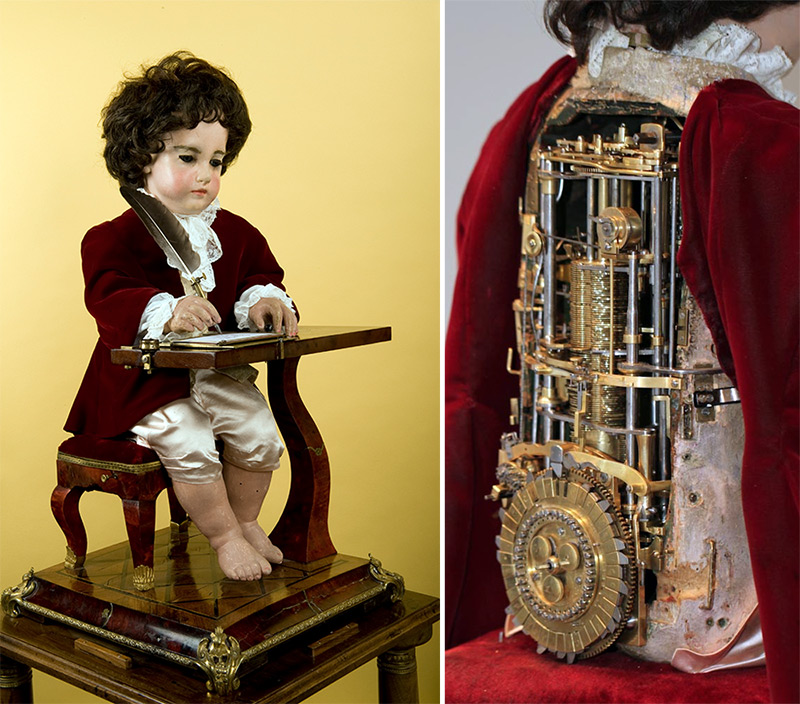
The characters that the boy prints on paper are encoded on a circular plate in the mechanism. This machine is more like an automatic printing press or printer. Surprisingly, the master provided the ability to change the text. The disc rotates and information about the symbols is transmitted sequentially to the actuator. The letters on the disk can be replaced, instead of characters can be put spaces.
Inside the doll there was a pile of eccentrics who turned the signal transmitted from the disc into hand movement.
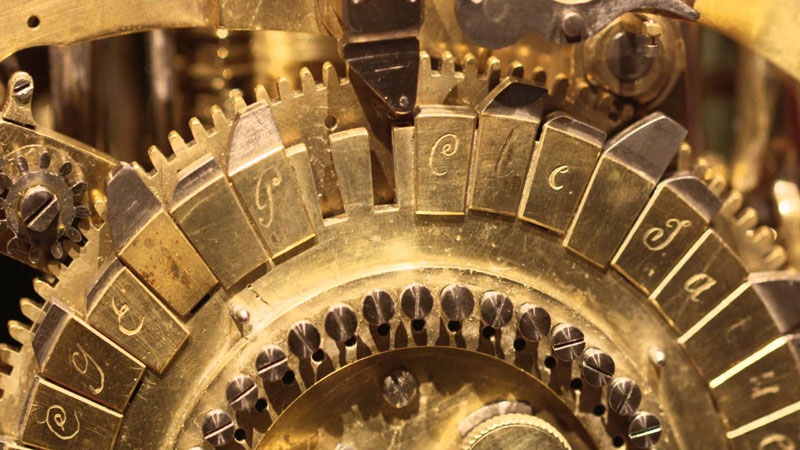
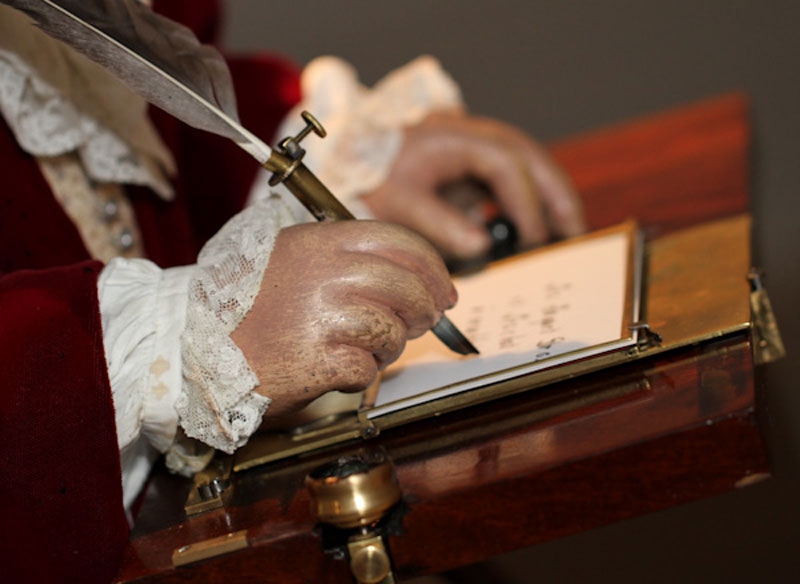
The Swiss watch brand, created by Pierre Jaquet-Dro, still exists today and makes these automatons to order. The production takes a year.
In 1810, the English master of Swiss origin, Henry Millardet, built a draftsman-writer. He wrote poems in three languages and beautifully designed them, and also painted images of Cupid in the garden or on the chariot, the ship, the Chinese temple.
The result was the following pictures:

In 1907, Gaston Descamp assembled the Zulma - snake charmer automaton. Here we see a girl opening her eyes, breathing and turning her neck, and moving a snake. All this is accompanied by music.
It was possible to earn money on automatons not only through their sale, but also with the help of a massive deception of people. It will now be about a Turkish chess player, one of whose interpretations in 1804 beat Napoleon.
Hungarian inventor Ferkash Kempelen assembled a full-sized human figure sitting at a chess table. At the beginning of the presentation, people were shown a mechanism inside the table and empty shelves, highlighting the inside of the table with a candle. Then the doors closed, and the game began.
The workplace of a live chess player was hidden inside. The main advantage of the automaton is that from the inside, the person controlled the hand of the Turk, and not only moved it, but grasped the figure and rearranged it, and also understood where and what figure it is thanks to the magnets in the lower part of the main chessboard. This is a great example of an early manipulator.
In the party against Napoleon defeated the Turks. Then Johann Algayer, the strongest Austrian chess player of the early 19th century, sat in the table.
To put it simply, almost all automata were winding mechanisms, like a clock, in some way connected with a doll or other figure and forcing it to move. The most surprising of them are the Calligrapher, due to the fact that the master initially provided for the possibility of reprogramming the mechanism, and the silver swan due to realism. But for ordinary people absolutely all working automata could seem a miracle.
But what did it look like a couple of hundred years ago? Or four hundred years? Yes, then there were also some similarities of robots, mechanical devices resembling a human or an animal. They played musical instruments, wrote with a pen, danced, growled, and performed other actions that could shock a simple philistine. Today we are talking about mechanical monks laying eggs for ducks and programmable writing boys.

Automata are mechanisms. Various stories about humanoid robots went back in Ancient Greece - for example, moving statues. But the not very complicated mechanism that Philo of Byzantine described, who died in 220 BC, looks much more real. In the book "Pneumatics" he described the device in the form of a woman who holds a jug of wine in one hand, and on command - when setting the glass in the other hand - she poured wine and added water to it. But who needs robots if there are slaves?
')
Leonardo Da Vinci, the greatest artist, scientist, musician and inventor, in the XV century, developed the technology of a humanoid mechanism. It was the first ever android. Before creating it, Da Vinci spent a lot of time in the anatomical school, cutting corpses and learning the secrets of the human body.
The mechanism was inside the knight's armor. A knight could possibly walk, stand up and sit down, move his arms and neck. Unfortunately, the video was not filmed.


Sketch - fantasy of our modern artist
The King of Spain, Philip II, in 1560 ordered the engineer Huanelo Turriano to create a mechanical monk. A monk could be baptized, raise a crucifix, move his lips - he seemed to pray for the king. The figure moved on wheels, but for realism there were also legs, which are visible from under the cassock.

In 1737, the French inventor Jacques de Vaucanson built a flutist, whose repertoire included twelve musical compositions, as well as a musician with a tambourine.
Light man like blacksmith furs. Vaucanson, also keen on working with corpses, imitated their work. He had to learn the game of a living person. The movement of air controlled the tongue, the lips opened, closed and moved, the air came in from mechanical lungs - furs.
Flute holes were clamped in the desired sequence of mechanical fingers. Since the wooden fingers could not fit snugly to the flute, the master used real human skin.


Later, Vaucanson designed and assembled a four-part duck, which flapped its wings, ate, digested the grain, and then defecated. According to the author, the duck had to actually digest food using a chemical reaction in a separate tank, but, unfortunately, it did not come to that. Instead, the grain fell into one compartment, and the prepared excrements left the other. The duck became his most famous creation. All three automatons entered one collection and made presentations to the public.


The most important detail for the construction of automata has become an eccentric - a disk or sector of a disk, mounted on a rotating shaft so that its axis does not coincide with the axis of rotation of the shaft. Thus, the rotational movement becomes translational.

Of course, where are we without the Japanese, when it comes to fine work. The doll in the video below is driven by the strings with which it is connected with a mechanism similar to a sentry. Eccentrics stretch the strings and release them, causing the doll to perform various actions.
This doll is not just moving hands. She takes an arrow, pulls on a bow string and releases it. Then he takes a new boom from the platform, which has changed his position during the shot. In this case, the archer has time to artistically move his head.
In the 1740s, Archbishop Jacob von Dietrinstein (Jakob von Dietrichstein) built an automaton, which is a theater of two hundred figures on the same stage, working simultaneously. So he portrayed the life of an ideal city. We see how the coopers close the barrel, hammer the bull with a hammer, the builders lift the boards onto the building, and the aristocracy is watching the hard work of ordinary people from above.
The water in the mechanism turns the wheel, which through several gears transmits the rotation to the drum. The drum contains instructions for each character in this theater.
Automatons are closely related to the art of creating watches. As you can see, almost always the masters of this particular area developed moving dolls. The world has built a lot of tower clocks with figures that perform actions. For example, this is the Prague Astronomical Clock. They were installed in 1410, this is the oldest of the currently operating astronomical clocks. In the 17th century, moving skeleton death figures with a bell and a screaming golden rooster were added to them.
Perhaps the most famous automaton in Russia is the peacock clock exhibited at the Hermitage Museum in St. Petersburg. The watches were made in the UK in the 1770s. Every Wednesday, Mikhail Guriev, head of the Laboratory of Clocks and Musical Mechanisms of the State Hermitage, turns them on, after which the hours run for eight hours.
Catherine II spent on the clock 11 000 rubles in 1781. When transporting from London, the mechanism was damaged, but Ivan Kulibin came to the rescue - he had to collect watches, taking parts from a pile in baskets.
Several birds are involved in the composition at once. An owl in a cage rotates his eyes, moves his head, and in time with the sound of bells, he dances with his paw. Peacock bows and spreads its tail. Then the rooster raises its head, and the ringing "crow" is heard.
Peacock created the London jeweler and inventor James Cox. Another interesting work of his was a silver swan with a long flexible neck, looking for food in a silver pond with fish. He works 40 seconds at one plant, but at the same time, it looks almost like a living one. While working, he catches a fish and eats it. Even water seems real - it is made of rotating glass cylinders with notches of various shapes.
In the 18th-19th centuries, automatons were the means of entertainment for the most affluent sections of society. But these works of art were made by much poorer people: artisans who produced components, and watchmakers who put them together. To earn more money, it was necessary to sell more mechanisms, and, perhaps, to reduce the price. Three hundred years ago, the trend began to miniaturize devices. And the clock became smaller, and the automata decreased in size.
The clockwork, which took place in the towers 500 years ago, has decreased to a size that allows them to be placed in a highly complicated version in the body of the doll. And then - in the device the size of a casket.
An example of a miniature automaton is this bird in a cage, made in the 1860s.
Another great example is the Laurel tree jewelry Easter egg, made by Carl Faberge in 1911 on the order of Nicholas II. He gave it to his mother, Maria Fedorovna. After planting the mechanism, the egg-tree cover opens and a bird appears. She turns and sings.
By the way, the company Jaquet Droz now has an automatic watch in the assortment. This watch with a songbird costs 380,000 Swiss francs, which is 25 million rubles.
In 1784, an automaton was assembled, made in the image of the Queen of France, Marie Antoinette. The doll rotates its eyes, looks around, moves its head, breathes and plays a musical instrument.
But Marie Antoinette in negligee. We see a notched drum that stretches the strings for each action in a certain sequence.

Machine guns not only played instruments, but were also able to write with pen on paper. Of course, strictly certain things, to reprogram such a doll was not an easy task (although there is an exception). In the video below - the work of 1773.
The “artist” of the master Jacquet Dro consists of 2,000 elements. He is able to draw three pictures: a portrait of Louis XV and his dogs with a signature, Marie-Antoinette with Louis XVI and Cupid, who controls the butt chariot. Its extraneous actions lend greater credibility to the mechanism — he fidgets in his chair, shakes his head and blows off the dust. It is difficult to imagine the surprise with which at that time could meet this robot.
A much more complicated mechanism by Jacquet Draw was called the Calligrapher. The device is assembled from 6,000 parts. The whole mechanism was placed in the body of the doll. Pen on paper boy diligently displays the text. After each letter with his second hand, he moves a sheet of paper to proceed to the next character, shakes the pen, dunks it in the inkwell.

The characters that the boy prints on paper are encoded on a circular plate in the mechanism. This machine is more like an automatic printing press or printer. Surprisingly, the master provided the ability to change the text. The disc rotates and information about the symbols is transmitted sequentially to the actuator. The letters on the disk can be replaced, instead of characters can be put spaces.
Inside the doll there was a pile of eccentrics who turned the signal transmitted from the disc into hand movement.


The Swiss watch brand, created by Pierre Jaquet-Dro, still exists today and makes these automatons to order. The production takes a year.
In 1810, the English master of Swiss origin, Henry Millardet, built a draftsman-writer. He wrote poems in three languages and beautifully designed them, and also painted images of Cupid in the garden or on the chariot, the ship, the Chinese temple.
The result was the following pictures:

In 1907, Gaston Descamp assembled the Zulma - snake charmer automaton. Here we see a girl opening her eyes, breathing and turning her neck, and moving a snake. All this is accompanied by music.
It was possible to earn money on automatons not only through their sale, but also with the help of a massive deception of people. It will now be about a Turkish chess player, one of whose interpretations in 1804 beat Napoleon.
Hungarian inventor Ferkash Kempelen assembled a full-sized human figure sitting at a chess table. At the beginning of the presentation, people were shown a mechanism inside the table and empty shelves, highlighting the inside of the table with a candle. Then the doors closed, and the game began.
The workplace of a live chess player was hidden inside. The main advantage of the automaton is that from the inside, the person controlled the hand of the Turk, and not only moved it, but grasped the figure and rearranged it, and also understood where and what figure it is thanks to the magnets in the lower part of the main chessboard. This is a great example of an early manipulator.
In the party against Napoleon defeated the Turks. Then Johann Algayer, the strongest Austrian chess player of the early 19th century, sat in the table.
To put it simply, almost all automata were winding mechanisms, like a clock, in some way connected with a doll or other figure and forcing it to move. The most surprising of them are the Calligrapher, due to the fact that the master initially provided for the possibility of reprogramming the mechanism, and the silver swan due to realism. But for ordinary people absolutely all working automata could seem a miracle.
Source: https://habr.com/ru/post/399133/
All Articles